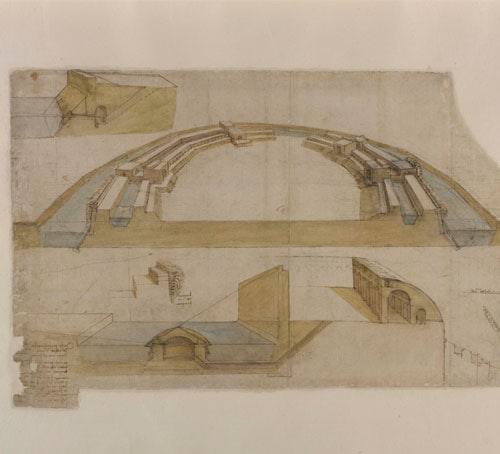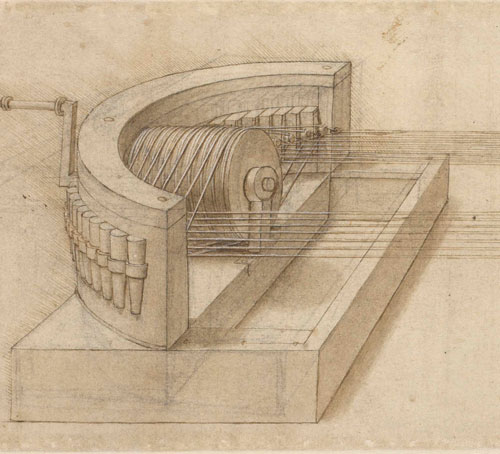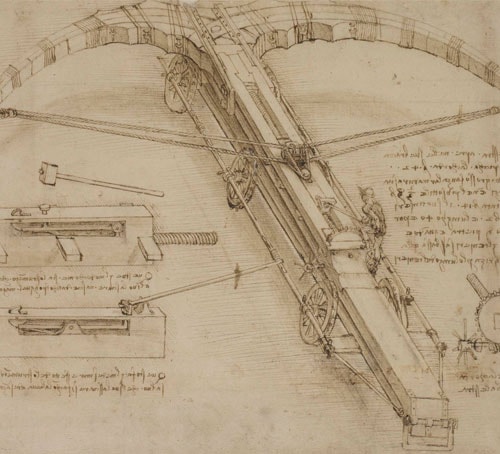At the heart of the exhibition is the display of original pages from the Codex Atlanticus. The Codex Atlanticus is the world’s largest collection of writings and drawings by Leonardo da Vinci, which explores a variety of subjects, from mathematics, to natural sciences, architecture, technology and music. For the first time in Southeast Asia, 13 original pages from da Vinci’s Codex Atlanticus are presented in this exhibition. In February 2015, these 13 pages will be replaced by 13 new pages from the Codex Atlanticus, providing visitors with the opportunity to experience 26 pages in total, over the lifespan of the exhibition.
The original pages are not only a testament to da Vinci’s innovative interdisciplinary approach, but have a history of their own. Since the death of da Vinci, they have been passed from hand to hand, bound together then unbound, studied by experts internationally, and travelled across the world. These masterpieces have stood the test of time, connecting people for centuries as they continue to inspire and shape the future.
In Da Vinci: Shaping the Future, the pages are displayed in a specially constructed gallery at the conclusion of the show.
The original pages are not only a testament to da Vinci’s innovative interdisciplinary approach, but have a history of their own. Since the death of da Vinci, they have been passed from hand to hand, bound together then unbound, studied by experts internationally, and travelled across the world. These masterpieces have stood the test of time, connecting people for centuries as they continue to inspire and shape the future.
In Da Vinci: Shaping the Future, the pages are displayed in a specially constructed gallery at the conclusion of the show.
- ORIGINAL PAGES

Studies for a Large Fortress
Circa 1502–03
F.116 recto
Leonardo da Vinci
Codex Atlanticus
Stylus, black pencil, pen and ink, watercolour
439 x 294 mm
A refined and precise study, this watercolour drawing was intended to be presented before a committee. Da Vinci used multiple perspectives to highlight the details of a fortress with two concentric barriers separated from each other by a moat. Two smaller details illustrate an underground passage around the base of the wall and a hay barrier which would be used to protect the structure. The style and technique da Vinci applied in this drawing were also used in his famous Map of Imola (1502), now part of the British Royal Collection.
Click here to find out more about da Vinci’s architectural studies.
F.116 recto
Leonardo da Vinci
Codex Atlanticus
Stylus, black pencil, pen and ink, watercolour
439 x 294 mm
A refined and precise study, this watercolour drawing was intended to be presented before a committee. Da Vinci used multiple perspectives to highlight the details of a fortress with two concentric barriers separated from each other by a moat. Two smaller details illustrate an underground passage around the base of the wall and a hay barrier which would be used to protect the structure. The style and technique da Vinci applied in this drawing were also used in his famous Map of Imola (1502), now part of the British Royal Collection.
Click here to find out more about da Vinci’s architectural studies.

Rope-making Device
Circa 1514–16
F.12 recto
Leonardo da Vinci
Codex Atlanticus
Pen and ink with finishing touches in watercolours and highlights in white lead
169 x 372 mm
Da Vinci completed this drawing while he was staying at the Vatican under the patronage of Giuliano de’ Medici. The drawing is highly refined and it is likely that it was produced for presentation purposes. It illustrates a machine that twists three strands of an unspecified material to form a thick rope or cable. Da Vinci may have completed this drawing for the construction project of Saint Peter’s Basilica located in Vatican City. Some scholars also believe this rope-making device may have been intended for the project to drain the Pontine Marshes. Hired by the Medici family, da Vinci was heavily involved in the project and designed a system to regulate floods in the area.
Click here to find out more about da Vinci’s technology studies.
F.12 recto
Leonardo da Vinci
Codex Atlanticus
Pen and ink with finishing touches in watercolours and highlights in white lead
169 x 372 mm
Da Vinci completed this drawing while he was staying at the Vatican under the patronage of Giuliano de’ Medici. The drawing is highly refined and it is likely that it was produced for presentation purposes. It illustrates a machine that twists three strands of an unspecified material to form a thick rope or cable. Da Vinci may have completed this drawing for the construction project of Saint Peter’s Basilica located in Vatican City. Some scholars also believe this rope-making device may have been intended for the project to drain the Pontine Marshes. Hired by the Medici family, da Vinci was heavily involved in the project and designed a system to regulate floods in the area.
Click here to find out more about da Vinci’s technology studies.

Giant Crossbow
Circa 1485–92
F.149 recto
Leonardo da Vinci
Codex Atlanticus
Metal stylus incisions, traces of black chalk, pen and ink and wash
413 x 277 mm
Da Vinci designed the giant crossbow of this folio to be a massive and terrifying threat. The technical and illustrative detail indicated in this folio makes it one of the most striking and celebrated of the Codex Atlanticus. Da Vinci included precise measurements of each component of the machine as well as a figure atop the machine to provide an indication of scale. To work the machine, a solider would spin a crank to pull back the bow and load the artillery, then use a mallet to knock out a holding pin and fire the weapon. The immense details provided in da Vinci’s crossbow folio are an example of how he used his artistic skill to illustrate complex technical matters.
Click here to find out more about da Vinci’s technology studies.
F.149 recto
Leonardo da Vinci
Codex Atlanticus
Metal stylus incisions, traces of black chalk, pen and ink and wash
413 x 277 mm
Da Vinci designed the giant crossbow of this folio to be a massive and terrifying threat. The technical and illustrative detail indicated in this folio makes it one of the most striking and celebrated of the Codex Atlanticus. Da Vinci included precise measurements of each component of the machine as well as a figure atop the machine to provide an indication of scale. To work the machine, a solider would spin a crank to pull back the bow and load the artillery, then use a mallet to knock out a holding pin and fire the weapon. The immense details provided in da Vinci’s crossbow folio are an example of how he used his artistic skill to illustrate complex technical matters.
Click here to find out more about da Vinci’s technology studies.